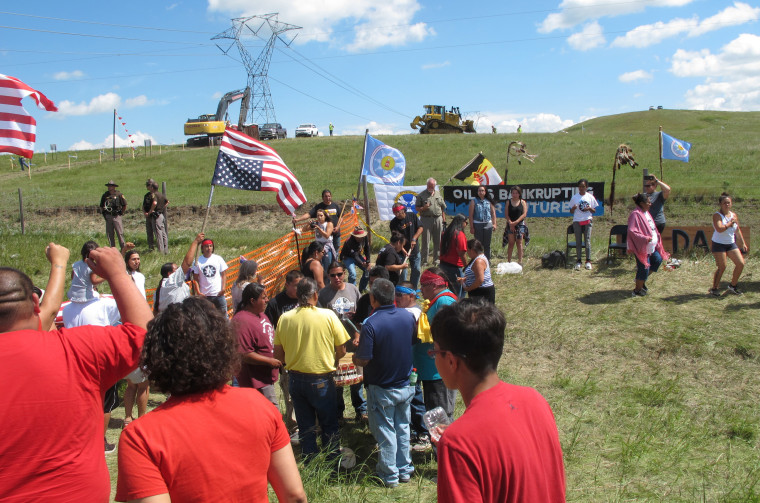Gracy Claymore remembers the moment the message flashed across her laptop screen.
On the morning of Aug. 3, a Texas company called Energy Transfer Partners sent her and all members of the Standing Rock Sioux Tribe a 48-hour construction notice on the controversial Dakota Access Pipeline — a 1,170-mile oil conduit slated to run from North Dakota to Illinois.
Part of the pipeline would traverse the Sioux's sacred, ancestral lands and run under the Missouri River, the tribe's sole water source. The pipeline would run just a half-mile from the Standing Rock reservation, which straddles the North and South Dakota border.
For Claymore, a 19-year-old student activist who along with dozens of her peers had protested the pipeline for months, warning against "the potential catastrophic environmental damage" an oil spill would bring for their people, it was now the time for action.
She corresponded with fellow members of the Oceti Sakowin Youth Group, a support network of student activists on the reservation. In July, the network organized a 2,000-mile long run from North Dakota to Washington, D.C., to bring awareness to their efforts to stop the construction of the pipeline.
They agreed to head to the contested site the following day and set up human barriers to block State Highway 1806 to the construction site. More than a month later, their numbers swelled from a few dozen to thousands. Claymore and her fellow activists had apparently sparked a movement.
And that movement is now at a crossroads: A federal judge was expected Friday to rule on the fate of the pipeline.

The Fight to Stop the Pipeline
The Dakota Access Pipeline, which is already more than half completed, is a massive $3.7 billion project that would transport 470,000 barrels of oil a day across four states from the oil fields in Stanley, North Dakota, near the Canadian border, to Patoka, in southern Illinois, where it would link with other existing pipelines. The project is financed by the Dallas-based Energy Transfer Partners, which claims it will bring millions of dollars into local economies and create an estimated 8,000 to 12,000 construction jobs.
Members of the Standing Rock Sioux tribe see the pipeline as both an environmental and cultural threat to their homeland. They say an oil spill would permanently contaminate the reservation's water supply and that construction of the pipeline would destroy lands where many of their ancestors are buried. The tribe says the U.S. Army Corps of Engineers, which has jurisdiction over the land, did not consult with them before granting Energy Transfer Partners "fast track" approval in July.
The tribe's fears of a potential oil spill seemed to gain further credence last month when the Bismarck Tribune reported that the pipeline's original proposed route would have crossed the Missouri River about 10 miles north of Bismarck, the state capital. According to the Tribune, records show that one reason the route was rejected was due to its proximity to Bismarck's water supply.
Energy Transfer Partners declined to comment for this article.
"It’s all about environmental justice," said a person closely associated with the tribe who lobbies on its behalf in Washington, D.C. “It's not only about Standing Rock, this is about a bigger issue that America does not acknowledge its own contracts with Native Americans.”
The pipeline has evidently touched a nerve across America's Indian Country. Of the Bureau of Indian Affairs' 566 federally recognized tribes, nearly 250 tribes have stood in solidarity with the Standing Rock Sioux at Cannon Ball, North Dakota — the site of the Oceti Sakowin Camp — with a rate of 10 tribes joining by the day, according to Dave Archambault, Chairman of the Standing Rock Sioux Tribe.
They've sent volunteers, supplies and logistical support to the estimated 3,000 to 4,000 in the camp. In some respects, the camp resembles a small town: There is a school and a working emergency health clinic, among other services. Those there call themselves protectors, not protesters.
Photo Gallery: The Fight for Standing Rock: Native Americans Defend Water, Sacred Land
For many tribes, the fight at Cannon Ball mirrors their own struggles to protect their territories from corporate land grabs in fights that, in some cases, date back more than a century. David Bean, a tribal council member of the Puyallup Tribe in Washington state, traveled to the site in a caravan this past weekend with eight other tribes, including the Yakama Nation and Nisqually.
Bean told NBC News that each tribe has its own "battle story." In the 1970s, the Puyallup Tribe fought for its right to fish collectively in Washington state's rivers when the Washington State Department of Fish and Wildlife still restricted natives from the bulk of their catch. In 2014, the Lummi tribe faced threats when SSA Marine proposed building a giant coal-fired power plant on its land. In both cases, tribes came from all directions to support them. Standing Rock is no different, said Bean.
“One thing we have always said [is] what affects one of us, affects all of us," said Bean. "We will always be there to support them as tribes have supported us.”
In a symbolic moment, the protests at Cannon Ball have brought the seven council fires of the Sioux Tribe together for the first time since 1876 at the Battle of Greasy Grass, commonly referred to as the Battle of Little Bighorn, when U.S. armed forces suffered a major defeat at the hands of the Sioux.
“This is the first time in history that all our tribes ever stood together like this,” Joleen Brown, a member of Standing Rock Sioux and Vice President of Native Hoop Magazine, told NBC News.

A Battle in the Courts
The protests forced a halt in construction last month after the tribe sued the U.S. Army Corps of Engineers, requesting a preliminary injunction to temporarily stop the project. The Army Corps of Engineers said it did not oppose the suspension. For its part, Energy Transfer Partners has sued several protesters, claiming they in some cases threatened and intimidated company-hired contractors who were working at the site.
On Wednesday, Green Party Presidential candidate Jill Stein and her running mate, Ajamu Baraka, were charged with criminal trespassing and criminal mischief, both misdemeanors, after spray painting construction equipment at the protest on Tuesday.
As the legal battle looms over the camp, there have occasionally been bouts of violence on the ground. On Sept. 3, private security guards with attack dogs and armed with pepper spray confronted a group of around 500 protesters, some of whom had chained themselves to bulldozers on the land. The tribe says at least 30 people were pepper sprayed and two individuals were injured from dog bites. The images of the protesters, including children, being attacked drew outrage online.
"We are investigating all unlawful acts relating to the protest activities," Morton County Sheriff Kyle Kirchmeier told NBC News.
U.S. District Judge James Boasberg is expected to rule Friday on the project's status moving forward. North Dakota Gov. Jack Dalrymple on Thursday activated the National Guard to the protest site ahead of the impending ruling.
NBC News spoke to nearly a dozen individuals who have taken part in the protests, from young activists to tribal elders. They expressed hope that whatever the outcome on Friday, they intended to stay for the long haul.
“What we’re doing is trying to make sure that all the members of the camp are understanding of the position and that is to remain peaceful," said Archambault. "This is just the beginning.”
For Bean, a legal victory on Friday "would be a David and Goliath moment."

Controversial Pipeline Brings Native Americans Rights to Mainstream
The Oceti Sakowin Camp in rural North Dakota is far from the halls of power in Washington, D.C.
In the age of social media, though, the photos and videos streaming live from the campsite on a daily basis have galvanized non-indigenous Americans and brought the issues of Native Americans' rights to the mainstream unlike any other event in decades, said Tara Houska, National Campaigns Director for Honor the Earth, a nonprofit organization focused on raising awareness and financial support for Indigenous environmental justice.
"We’re kind of seeing an attitude that ‘enough is enough,'" Houska told NBC News. "I think a lot of Americans are very familiar with destructive extraction industry projects and understand this struggle that Native Americans are going through to survive on their own lands."
In Washington, the response to the protests has been relatively muted — especially when compared to the proposed Keystone Pipeline that divided both major political parties. President Barack Obama, who visited the Standing Rock reservation in June 2014, has not spoken publicly about the standoff. North Dakota's two senators, Democratic Sen. Heidi Heitkamp and Republican Sen. John Hoeven, have not always made their positions clear.
In statements provided to NBC News, both senators did not explicitly state their support of or opposition to the Dakota Access Pipeline. Both said they would closely monitor the court proceedings and said the protesters were well within their rights to demonstrate if they felt their concerns were not being adequately addressed.
For Gracy Claymore, the attention received from "non-Indians" was welcome. "We're usually invisible to most of America, so when you see celebrities join the cause to help us, it really means a lot for our struggle."
She says she hopes that issues like poverty and high unemployment that have plagued her reservation for years may finally get the attention they deserve now with the nation's attention on this section of the heartland. “The lands mean everything to me," Claymore told NBC News.
As for what her next steps might be if the Standing Rock Sioux lose this legal fight, Claymore admits she hasn't given it much thought. For a teenager now on the front lines of her tribe's biggest fight in generations, Claymore doesn't appear to have fully digested the last month. "It's been a whirlwind," she said.
